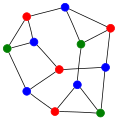Frucht graph
| Frucht graph | ||
|---|---|---|
Chromatic index 3 | | |
| Properties | Cubic Halin Pancyclic | |
| Table of graphs and parameters | ||
In the mathematical field of graph theory, the Frucht graph is a cubic graph with 12 vertices, 18 edges, and no nontrivial symmetries.[1] It was first described by Robert Frucht in 1939.[2]
The Frucht graph is a
The Frucht graph can be constructed from the LCF notation: [−5,−2,−4,2,5,−2,2,5,−2,−5,4,2].
Algebraic properties
The Frucht graph is one of the five smallest cubic graphs possessing only a single graph automorphism, the identity[3] (that is, every vertex can be distinguished topologically from every other vertex). Such graphs are called asymmetric (or identity) graphs. Frucht's theorem states that any group can be realized as the group of symmetries of a graph,[2] and a strengthening of this theorem also due to Frucht states that any group can be realized as the symmetries of a 3-regular graph;[4] the Frucht graph provides an example of this realization for the trivial group.
The
Gallery
-
Thechromatic numberof the Frucht graph is 3.
-
The Frucht graph isHamiltonian.
See also
References
- ^ Weisstein, Eric W., "Frucht Graph", MathWorld
- ^ Zbl 0020.07804.
- ^ Bussemaker, F. C.; Cobeljic, S.; Cvetkovic, D. M.; Seidel, J. J. (1976), Computer investigation of cubic graphs, EUT report, vol. 76-WSK-01, Dept. of Mathematics and Computing Science, Eindhoven University of Technology
- S2CID 124723321.



